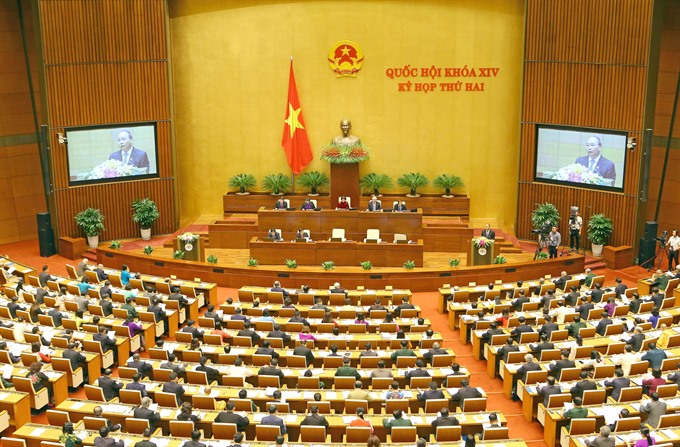 Politics & Law
Politics & Law

Prime Minister Nguyễn Xuân Phúc is concerned that Việt Nam might fail to achieve its GDP goal of 6.7 per cent this year.
 |
| National Assembly deputies attend the opening ceremony of the National Assembly’s second meeting, which was held in Hà Nội yesterday. — VNA/VNS Photo Doãn Tấn |
HÀ NỘI – Prime Minister Nguyễn Xuân Phúc is concerned that Việt Nam might fail to achieve its GDP goal of 6.7 per cent this year.
In his report on the country’s socio-economic development in 2016 delivered to the National Assembly (NA) yesterday, Phúc said the average economic growth in the last three quarters only reached 5.97 per cent. This was much lower than the GDP growth rate of 6.5 per cent in the same period last year.
At the second meeting of the newly-elected NA, which opened yesterday morning, the PM said projected GDP growth this year may only reach 6.3-6.5 per cent, lower than the original target of 6.7 per cent set by the previous NA.
“That economic growth has failed to meet the goal will affect other targets, for example it will lead to higher budget deficit and public debt,” Phúc said.
Việt Nam’s public debt was among the top issues on the Government’s agenda as it has already crossed the red line set by the NA at 65 per cent of the GDP. The Ministry of Planning and Investment in its latest report released last month issued a warning that the risk of public debt climbing beyond the ceiling rate was becoming “more apparent".
Despite the looming risk that Việt Nam might not be able to reach the GDP goal this year, the Government has still proposed a GDP target of 6.7 per cent for next year, according to Phúc.
Economy restructure
The NA yesterday also heard Government reports on the economic restructuring plan and the management of public debt during the 2016-20 period.
According to the Government report on the economic restructuring plan during the 2016-20 period, the plan has an overall target of restructuring the economy linked to the shifting growth model, focusing on improving the effectiveness of the distribution and use of development resources, through which a more reasonable and dynamic economic structure with higher productivity, higher competitiveness, bigger growth potential and ensuring sustainable, clean and green growth.
The restructure will focus on developing the domestic private sector and foreign direct investment attraction; restructuring the State sector; restructuring the finance market; modernising the planning of economic sectors and economic regions towards increasing productivity, quality, efficiency in connection with promoting international integration; and restructuring the markets of important products, including the land use rights market, labour force market and science and technology market.
To achieve the targets, the plan put forth key tasks, including improving the business environment and supporting the development of the private sector; resolutely equitising and withdrawing State capital following approved plans; completing public investment mechanism; restructuring agencies providing public services; speeding up the handling of bad debts; expanding the scale, number and quality of investors and products and improving the efficient operation of the stock market and the securities market; modernising planning tasks; encouraging the expansion of safety standard production models to ensure quality of farm products; and developing and restructuring prioritised economic sectors.
In the report on public debt management during 2016-2020, the Government proposes to increase the cap on Government debt from 50 per cent to 55 per cent of GDP. However, the NA Committee on Finance and Budget said, after examining the Government report, that because the State budget still faces many difficulties and national financial security was not firm enough, so a rate of 53 per cent could be considered but it should be reduced to 50 per cent by 2020.
The Government report on mid-term public investment plan sets a target of maximising the attraction and effectively using investment capital sources to develop the economy and complete basic infrastructure systems for the implementation of the socio-economic development strategies during 2011-2020 and during 2016-2020.
Total social investment capital during the 2016-2020 period is estimated at VNĐ9.12-9.75 quadrillion (US$408-435 billion), equivalent to 32-34 per cent of GDP, including VNĐ2 quadrillion from the State budget, accounting for 20.5 per cent.
Public investment will focus on 14 key sectors, including agro-forestry, fishery and irrigation; industrial sector; transport; education and training; information technology; science and technology; natural resources and environment and healthcare and food safety and hygiene.
The Government report on medium-term investment capital said total medium-term investment capital from the State budget during the 2016-20 period is estimated at VNĐ2 quadrillion.
Capital distribution will target national target programmes on building new rural areas and sustainable poverty reduction and key socio-economic development projects, prioritising projects on agricultural restructure, development of satellite hospitals, climate change adaptation and natural disaster prevention and control. – VNS




